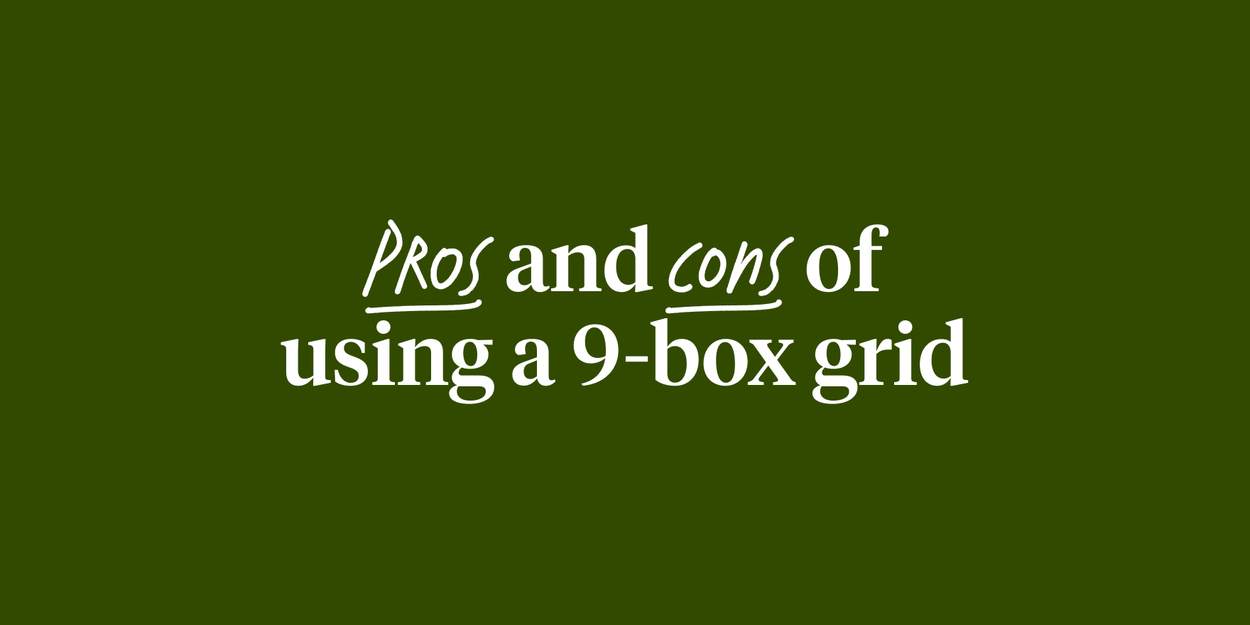
Pros and cons of using a 9-box grid for succession planning

Written by

Lead People Scientist, Culture Amp
While the 9-box grid (also known as the 9-box matrix) is a well-known and widely used people management tool, it’s also a somewhat controversial one. Although many organizations currently use the 9-box to visualize an evaluation of employee performance and potential, this approach is increasingly met with opposition. In fact, a growing number of organizations and HR professionals now acknowledge this talent tool as unreliable and biased – but why?
In this article, we’ll explore what a 9-box grid is, and share the pros and cons of using this tool in your performance management and succession planning strategy. Familiarizing yourself with the benefits and shortcomings of the 9-box grid allows you to make a more informed decision as to whether it's the right tool for your organization.
What is a 9-box grid in performance management?
The 9-box grid is a three-by-three matrix with two axes: performance (vertical) and potential (horizontal). This tool is used to inform both performance management and talent mapping, as HR professionals can use it to visualize the assessment of both the current performance of an employee and their future potential.
As the 9-box tool’s name suggests, there are nine categories where an employee can be placed, ranging from Immediate Improvement Required to High Potential.

How do organizations use the 9-box grid?
Organizations generally use the 9-box to accomplish one of three goals:
1. Identify high-potential talent. The grid is easy to implement and execute on, thereby enabling managers to quickly rank employees and highlight their highest-performing direct reports.
2. Inform organizational development needs. By identifying both low- and high-performing individuals, HR teams can surface L&D trends and pinpoint specific knowledge and skill gaps within the organization, allowing them to get ahead of internal training needs.
3. Kick off succession planning. Some organizations use the 9-box grid to identify employees that have a high potential of taking on more specialized or senior roles in the future. Businesses may also use this tool to determine if there is a need for an external hire (i.e., if there is no high-potential employee that is fit for the opportunity).
Should your organization use the 9-box?
While many businesses use the grid to identify future organizational leaders and inform employee development decisions, the use of the 9-box grid is often debated as a HR and people practice. While some HR professionals see it as a straightforward model that informs their people strategy, others see it as an outdated approach that is too focused on labels.
With all the uncertainty and ambiguity around the tool, how can you be certain that the 9-box matrix is or isn’t the right tool for your business? In this section, we share both the benefits and downsides of using the 9-box grid as a performance management and talent tool.
Benefits of using the 9-box matrix
-
Provides easy-to-understand, visual data
HR, CEOs, and other senior leaders can be particular when it comes to how they want to receive people data. Since executives often prefer to see data visually, many HR pros like to lean on the 9-box tool to easily and impactfully depict an individual’s performance and potential. -
Simplifies hiring and recruitment
It’s expensive to recruit and train new team members – especially for more senior roles that have a higher cost to fill. Since filling a vacant role with an internal hire is more cost-efficient, it’s important for organizations to understand their current talent pool and grow leaders from within. The 9-box grid can be useful in the process of identifying promising candidates for internal promotion – in fact, organizations that use the grid likely have already identified a group of employees that are categorized as “high potential.” -
Creates a level of consistency in the performance process
Many organizations use the 9-box grid to align senior leadership and mid-level managers during the performance review process. The tool requires that leadership and management teams agree on performance expectations – for example, to determine and define what constitutes high, medium, and low performance. In that way, the grid helps clarify leaders’ expectations and goals for the organization.
Downsides of using the 9-box tool
-
Lacks reliability
Put simply, there’s no standard or particularly reliable way to measure individual potential – making it a dubious tool for effective succession planning. A 2015 study on potential found that when companies tried to predict whether an employee would move 2 levels in 5 years, they were only accurate at identifying these high-potential individuals 52% of the time. This limited predictive validity is a huge problem because it implies that organizations are misidentifying and/or missing out on future leaders. -
Exacerbates bias.
Unfortunately, categorizing employees based on their potential is often a biased process. While you can mitigate the effects of bias by collecting input from several individuals rather than a single manager, bias and favoritism can still creep in.
For example, our people scientists have found that the 9-box grid can often introduce the halo/horns effect – which is when one good or bad trait overshadows others (i.e., overlooking an employee’s below-average work because they’re well-liked on the team). This can greatly undermine employees’ trust in the performance process and impede an organization’s ability to properly recognize and reward high-performing employees. -
Negatively impacts historically marginalized employees
Employees from historically marginalized backgrounds can be adversely affected by the 9-box matrix’s inherent subjectivity. Unconscious biases are real and can lead to these individuals receiving lower rankings than their colleagues and being overlooked for senior leadership roles. For example, a 2022 research study analyzing 9-box data for almost 30,000 employees found that women receive substantially lower “potential” ratings than men, despite receiving higher job performance ratings. In this way, the 9-box tool can sabotage an organization's DEI efforts by unintentionally barring underrepresented employees from leadership positions. This can decrease overall levels of diversity as these employees will likely become demotivated and leave the company for better opportunities. -
Can greatly discourage employees and encourage a fixed mindset
While individuals marked as high potential might be thrilled by their results and the business’ newfound interest in their development and career, employees who fall at the other end of the spectrum may become disheartened and demotivated. A poor ranking can negatively impact employee productivity, especially if employees feel these assessments were subjective or unfair – which, as discussed earlier, 9-box assessments often are.
If you choose to use a 9-box grid, be careful and intentional about the “names” or “labels” associated with each box. For example, some grids use labels like “dysfunctional geniuses” or “bad hires”, which can hurt an employee’s identity and confidence.
You’ll also want to be cognizant of the impact of labels themselves. Unfortunately, assigning a “name” to potential can shape a manager’s belief in their employee and that employee’s self-esteem. This encourages a fixed mindset, meaning that people believe that they themselves and/or others cannot change or improve, rather than promoting a growth mindset, which is the belief that everyone has the potential to change and improve.
At Culture Amp, we believe that it’s precisely this growth mindset that promotes a culture of high performance and continuous growth – employees that believe they can be better will naturally work harder to develop and improve. Unfortunately, the 9-box grid often drives the opposite result by pigeonholing employees into a box.
With all this said, we generally don’t recommend using the 9-box grid. The benefits are limited, and the cons go against our philosophy of objective, transparent, and equitable performance management. Tools like Culture Amp’s employee experience platform offer richer data, provide a science-backed and objective process for identifying high performers, promote a growth mindset, and make it easy and motivating to build personalized employee development plans. The simplicity of the 9-box grid is both its greatest appeal and its Achilles heel – “potential” is almost impossible to accurately measure, and the act of categorization can demotivate, disengage, and ultimately drive your talent away.
Unlock a better performance management process
There are benefits and downsides to every tool, and the 9-box grid is no exception. Every organization has unique nuances and historical processes, which means what works for another business might not be right for yours and vice versa. While the 9-box grid might be a good fit for your people management processes, tread lightly. Do everything you can to mitigate the manager bias and employee distrust that often come hand-in-hand with using this tool.
On the other hand, if you’ve realized an employee experience might be a better fit for your business and people goals, we’d love to show you what the Culture Amp platform can do.

